在线考试系统外文翻译
- 格式:doc
- 大小:44.00 KB
- 文档页数:11
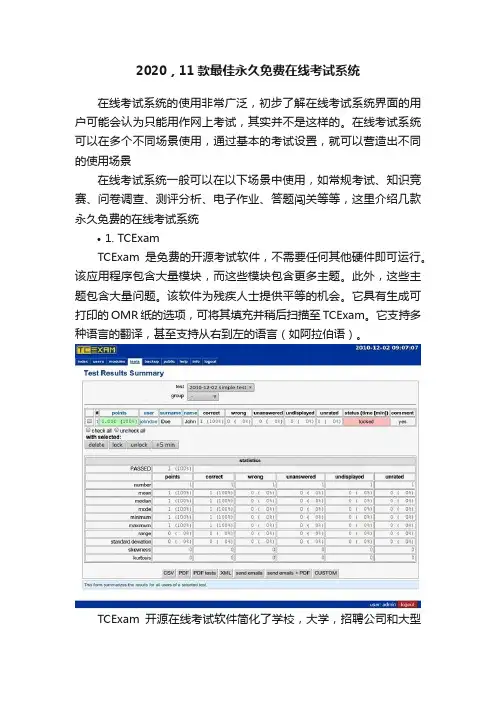
2020,11款最佳永久免费在线考试系统在线考试系统的使用非常广泛,初步了解在线考试系统界面的用户可能会认为只能用作网上考试,其实并不是这样的。
在线考试系统可以在多个不同场景使用,通过基本的考试设置,就可以营造出不同的使用场景在线考试系统一般可以在以下场景中使用,如常规考试、知识竞赛、问卷调查、测评分析、电子作业、答题闯关等等,这里介绍几款永久免费的在线考试系统•1. TCExamTCExam是免费的开源考试软件,不需要任何其他硬件即可运行。
该应用程序包含大量模块,而这些模块包含更多主题。
此外,这些主题包含大量问题。
该软件为残疾人士提供平等的机会。
它具有生成可打印的OMR纸的选项,可将其填充并稍后扫描至TCExam。
它支持多种语言的翻译,甚至支持从右到左的语言(如阿拉伯语)。
TCExam开源在线考试软件简化了学校,大学,招聘公司和大型组织的评估流程,使他们能够高效地创建和管理考试,测试,测验和调查。
TCExam的功能1.可根据您的要求进行配置2.您可以将数据导入和导出到此软件中3.它具有生成可打印的OMR表的选项4.您可以添加多媒体内容•2. VirtualXVirtualX是完全免费的开源考试软件,可以在大学,公司和电子学习组织中使用。
它支持12种不同类型的问题,例如多项选择题,填空,是或否,拖放等。
VirtualX在线考试系统php开源还生成五种不同类型的报告,包括图形报告和文本报告,这有利于进行进一步分析的考试。
还为VirtualX中的描述性问题提供了手动评估选项。
它提供三种不同版本,可满足不同组织的不同需求。
:i)托管VirtualX:您可以运行VirtualX,而无需强调与托管相关的任何问题。
ii)集成现有的学校管理软件:您可以将任何现有的学习管理软件与VirtualX集成。
iii)自定义VirtualX:您可以根据组织的需要自定义VirtualX。
VirtualX在线考试软件开源php也有一个Pro版本,其中包含基本计划,basic plus计划和高级计划。
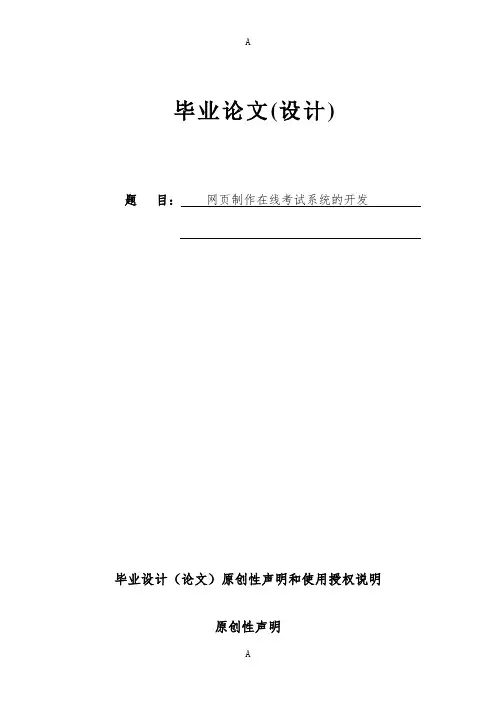
毕业论文(设计)题目:网页制作在线考试系统的开发毕业设计(论文)原创性声明和使用授权说明原创性声明人郑重承诺:所呈交的毕业设计(论文),是我个人在指导教师的指导下进行的研究工作及取得的成果。
尽我所知,除文中特别加以标注和致谢的地方外,不包含其他人或组织已经发表或公布过的研究成果,也不包含我为获得及其它教育机构的学位或学历而使用过的材料。
对本研究提供过帮助和做出过贡献的个人或集体,均已在文中作了明确的说明并表示了谢意。
者签名:日期:导教师签名:日期:使用授权说明人完全了解大学关于收集、保存、使用毕业设计(论文)的规定,即:按照学校要求提交毕业设计(论文)的印刷本和电子版本;学校有权保存毕业设计(论文)的印刷本和电子版,并提供目录检索与阅览服务;学校可以采用影印、缩印、数字化或其它复制手段保存论文;在不以赢利为目的前提下,学校可以公布论文的部分或全部内容。
作者签名:日期:学位论文原创性声明本人郑重声明:所呈交的论文是本人在导师的指导下独立进行研究所取得的研究成果。
除了文中特别加以标注引用的内容外,本论文不包含任何其他个人或集体已经发表或撰写的成果作品。
对本文的研究做出重要贡献的个人和集体,均已在文中以明确方式标明。
本人完全意识到本声明的法律后果由本人承担。
作者签名:日期:年月日学位论文版权使用授权书本学位论文作者完全了解学校有关保留、使用学位论文的规定,同意学校保留并向国家有关部门或机构送交论文的复印件和电子版,允许论文被查阅和借阅。
本人授权大学可以将本学位论文的全部或部分内容编入有关数据库进行检索,可以采用影印、缩印或扫描等复制手段保存和汇编本学位论文。
涉密论文按学校规定处理。
者签名:日期:年月日师签名:日期:年月日注意事项1.设计(论文)的内容包括:)封面(按教务处制定的标准封面格式制作)2)原创性声明3)中文摘要(300字左右)、关键词4)外文摘要、关键词5)目次页(附件不统一编入)6)论文主体部分:引言(或绪论)、正文、结论7)参考文献8)致谢9)附录(对论文支持必要时)2.论文字数要求:理工类设计(论文)正文字数不少于1万字(不包括图纸、程序清单等),文科类论文正文字数不少于1.2万字。
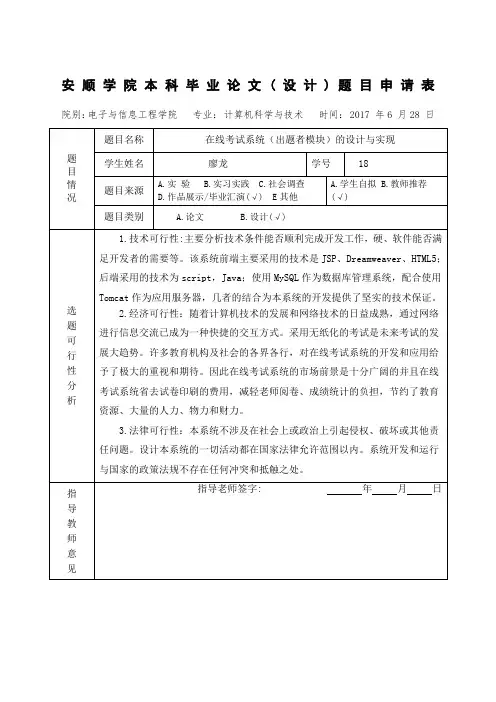

在线考试系统系统需求规格说明书版本:1.0说明:本说明书仅供参考,严禁抄袭!变更记录目录1.简介 (4)1.1开发背景 (4)1.2目的 (4)1.3业务范围 (4)1.4参考文档 (4)2.约束及假定 (5)2.1 软件运行环境以及技术约束 (5)2.1.1 软件约束 (5)2.1.2 资产约束 (5)2.2 交付及部署约束 (5)3.功能性需求 (6)3.1 系统功能简介 (6)3.2 需求描述 (6)3.2.1学生端 (6)3.2.2教师端 (6)3.2.3 参考界面设计 (8)4.非功能性需求 (11)4.1 性能 (11)4.2 可扩展性 (11)4.3 可用性 (11)4.4 安全性 (11)4.5 易用性 (12)5.数据库设计 (13)1.简介1.1开发背景系统名称:在线考试系统[以下简称ZXKS系统];本项目的任务提出者是某学校。
开发者为QG公司;系统用户是使用此系统的工作人员;本项目是某学校教务管理系统平台的一部分。
1.2目的本文档定义了ZXKS系统的详细需求,明确了ZXKS系统的功能内容、功能边界、开发途径。
1.3业务范围在线考试系统用来支持在线考试,实现教师出题、学生在线考试以及相关的系统维护功能。
在线考试系统是一个web应用形式,可以通过互联网进行访问。
1.4参考文档2.约束及假定2.1 软件运行环境以及技术约束2.1.1 软件约束ZXKS系统采用Java技术进行开发。
开发及运行的软件环境为:●Java开发包JDK:jdk-1_5_0_01-windows版●应用服务器Tomcat:jakarta-tomcat-5.0.16●数据库SQL Server2005 或MySQL●开发框架:MVC(JSP+Servlet+JavaBean)2.1.2 资产约束Web服务器及数据库服务器均采用Intel P4(1.8G HZ)PC 工作站。
内存1024M、硬盘120G。
2.2 交付及部署约束ZXKS系统要在3周内开发完成,交付时要以独立的war文件作为应用程序发布形式。
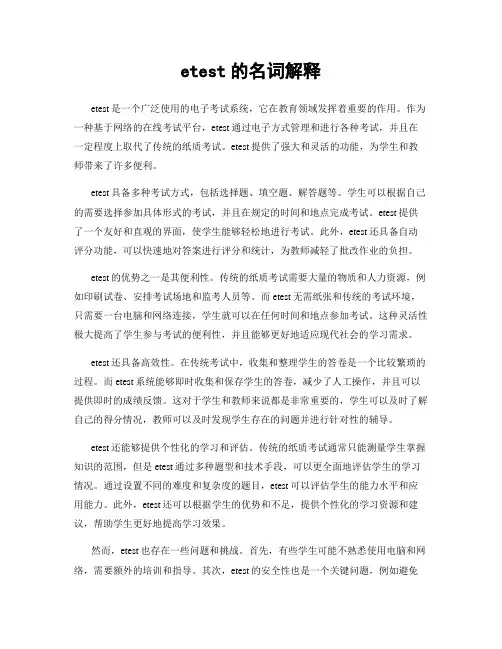
etest的名词解释etest是一个广泛使用的电子考试系统,它在教育领域发挥着重要的作用。
作为一种基于网络的在线考试平台,etest通过电子方式管理和进行各种考试,并且在一定程度上取代了传统的纸质考试。
etest提供了强大和灵活的功能,为学生和教师带来了许多便利。
etest具备多种考试方式,包括选择题、填空题、解答题等。
学生可以根据自己的需要选择参加具体形式的考试,并且在规定的时间和地点完成考试。
etest提供了一个友好和直观的界面,使学生能够轻松地进行考试。
此外,etest还具备自动评分功能,可以快速地对答案进行评分和统计,为教师减轻了批改作业的负担。
etest的优势之一是其便利性。
传统的纸质考试需要大量的物质和人力资源,例如印刷试卷、安排考试场地和监考人员等。
而etest无需纸张和传统的考试环境,只需要一台电脑和网络连接,学生就可以在任何时间和地点参加考试。
这种灵活性极大提高了学生参与考试的便利性,并且能够更好地适应现代社会的学习需求。
etest还具备高效性。
在传统考试中,收集和整理学生的答卷是一个比较繁琐的过程。
而etest系统能够即时收集和保存学生的答卷,减少了人工操作,并且可以提供即时的成绩反馈。
这对于学生和教师来说都是非常重要的,学生可以及时了解自己的得分情况,教师可以及时发现学生存在的问题并进行针对性的辅导。
etest还能够提供个性化的学习和评估。
传统的纸质考试通常只能测量学生掌握知识的范围,但是etest通过多种题型和技术手段,可以更全面地评估学生的学习情况。
通过设置不同的难度和复杂度的题目,etest可以评估学生的能力水平和应用能力。
此外,etest还可以根据学生的优势和不足,提供个性化的学习资源和建议,帮助学生更好地提高学习效果。
然而,etest也存在一些问题和挑战。
首先,有些学生可能不熟悉使用电脑和网络,需要额外的培训和指导。
其次,etest的安全性也是一个关键问题,例如避免作弊和保护学生隐私等。
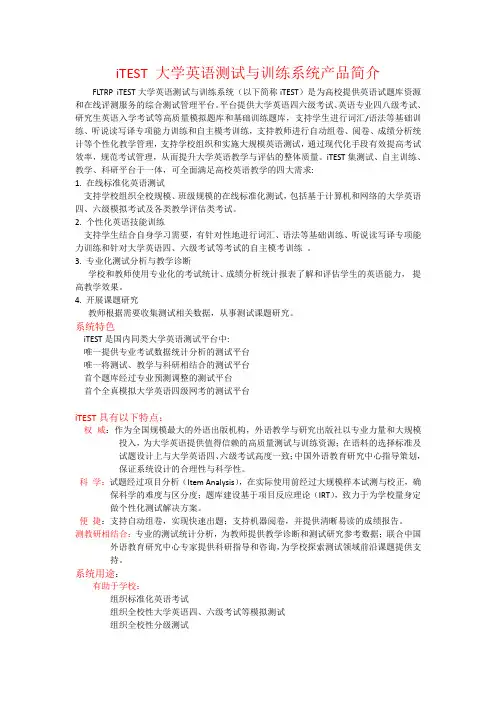
iTEST 大学英语测试与训练系统产品简介FLTRP iTEST大学英语测试与训练系统(以下简称iTEST)是为高校提供英语试题库资源和在线评测服务的综合测试管理平台。
平台提供大学英语四六级考试、英语专业四八级考试、研究生英语入学考试等高质量模拟题库和基础训练题库,支持学生进行词汇/语法等基础训练、听说读写译专项能力训练和自主模考训练,支持教师进行自动组卷、阅卷、成绩分析统计等个性化教学管理,支持学校组织和实施大规模英语测试,通过现代化手段有效提高考试效率,规范考试管理,从而提升大学英语教学与评估的整体质量。
iTEST集测试、自主训练、教学、科研平台于一体,可全面满足高校英语教学的四大需求:1. 在线标准化英语测试支持学校组织全校规模、班级规模的在线标准化测试,包括基于计算机和网络的大学英语四、六级模拟考试及各类教学评估类考试。
2. 个性化英语技能训练支持学生结合自身学习需要,有针对性地进行词汇、语法等基础训练、听说读写译专项能力训练和针对大学英语四、六级考试等考试的自主模考训练。
3. 专业化测试分析与教学诊断学校和教师使用专业化的考试统计、成绩分析统计报表了解和评估学生的英语能力,提高教学效果。
4. 开展课题研究教师根据需要收集测试相关数据,从事测试课题研究。
系统特色iTEST是国内同类大学英语测试平台中:唯一提供专业考试数据统计分析的测试平台唯一将测试、教学与科研相结合的测试平台首个题库经过专业预测调整的测试平台首个全真模拟大学英语四级网考的测试平台iTEST具有以下特点:权威:作为全国规模最大的外语出版机构,外语教学与研究出版社以专业力量和大规模投入,为大学英语提供值得信赖的高质量测试与训练资源;在语料的选择标准及试题设计上与大学英语四、六级考试高度一致;中国外语教育研究中心指导策划,保证系统设计的合理性与科学性。
科学:试题经过项目分析(Item Analysis),在实际使用前经过大规模样本试测与校正,确保科学的难度与区分度;题库建设基于项目反应理论(IRT),致力于为学校量身定做个性化测试解决方案。
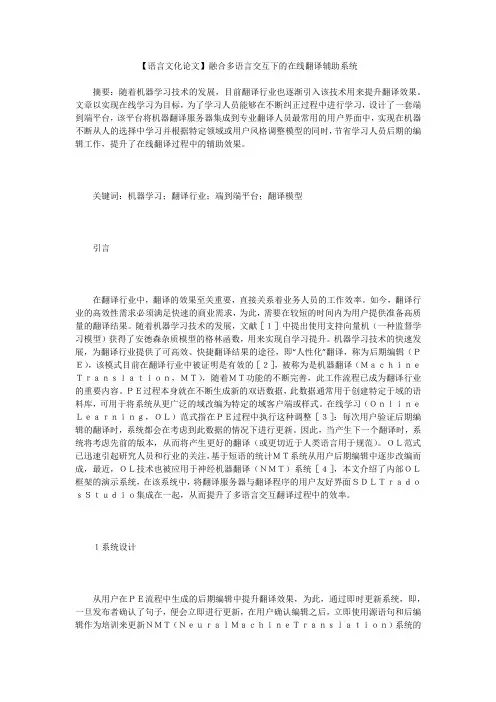
【语言文化论文】融合多语言交互下的在线翻译辅助系统摘要:随着机器学习技术的发展,目前翻译行业也逐渐引入该技术用来提升翻译效果。
文章以实现在线学习为目标,为了学习人员能够在不断纠正过程中进行学习,设计了一套端到端平台,该平台将机器翻译服务器集成到专业翻译人员最常用的用户界面中,实现在机器不断从人的选择中学习并根据特定领域或用户风格调整模型的同时,节省学习人员后期的编辑工作,提升了在线翻译过程中的辅助效果。
关键词:机器学习;翻译行业;端到端平台;翻译模型引言在翻译行业中,翻译的效果至关重要,直接关系着业务人员的工作效率。
如今,翻译行业的高效性需求必须满足快速的商业需求,为此,需要在较短的时间内为用户提供准备高质量的翻译结果。
随着机器学习技术的发展,文献[1]中提出使用支持向量机(一种监督学习模型)获得了安德森杂质模型的格林函数,用来实现自学习提升。
机器学习技术的快速发展,为翻译行业提供了可高效、快捷翻译结果的途径,即“人性化”翻译,称为后期编辑(PE),该模式目前在翻译行业中被证明是有效的[2],被称为是机器翻译(MachineTranslation,MT),随着MT功能的不断完善,此工作流程已成为翻译行业的重要内容。
PE过程本身就在不断生成新的双语数据,此数据通常用于创建特定于域的语料库,可用于将系统从更广泛的域改编为特定的域客户端或样式。
在线学习(OnlineLearning,OL)范式指在PE过程中执行这种调整[3]:每次用户验证后期编辑的翻译时,系统都会在考虑到此数据的情况下进行更新。
因此,当产生下一个翻译时,系统将考虑先前的版本,从而将产生更好的翻译(或更切近于人类语言用于规范)。
OL范式已迅速引起研究人员和行业的关注,基于短语的统计MT系统从用户后期编辑中逐步改编而成,最近,OL技术也被应用于神经机器翻译(NMT)系统[4],本文介绍了内部OL框架的演示系统,在该系统中,将翻译服务器与翻译程序的用户友好界面SDLTradosStudio集成在一起,从而提升了多语言交互翻译过程中的效率。
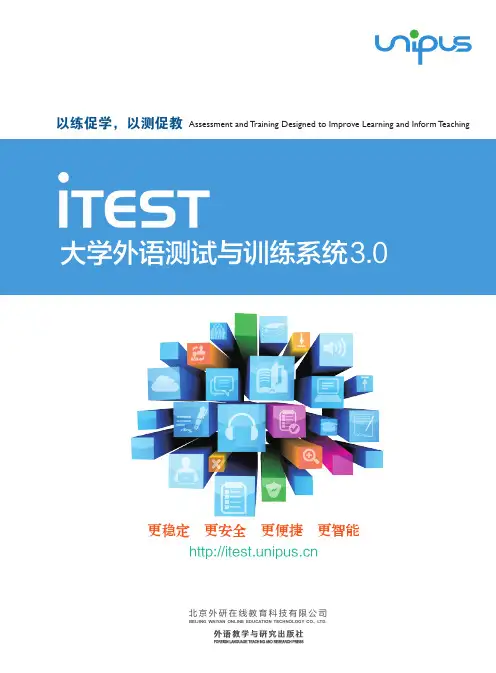
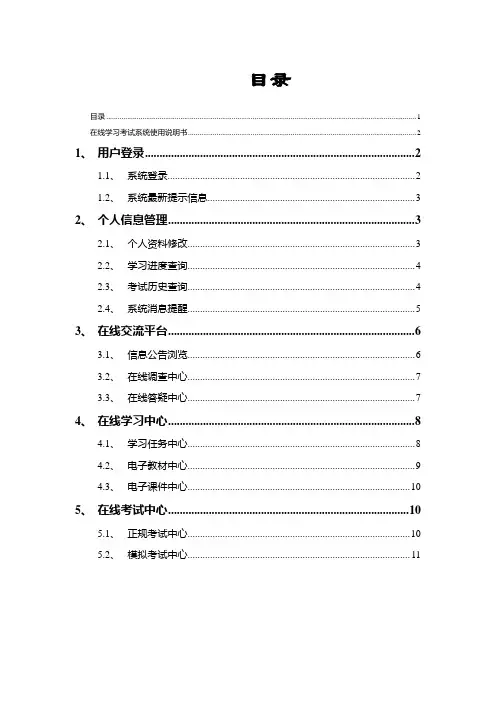
目录目录 (1)在线学习考试系统使用说明书 (2)1、用户登录 (2)1.1、系统登录 (2)1.2、系统最新提示信息 (3)2、个人信息管理 (3)2.1、个人资料修改 (3)2.2、学习进度查询 (4)2.3、考试历史查询 (4)2.4、系统消息提醒 (5)3、在线交流平台 (6)3.1、信息公告浏览 (6)3.2、在线调查中心 (7)3.3、在线答疑中心 (7)4、在线学习中心 (8)4.1、学习任务中心 (8)4.2、电子教材中心 (9)4.3、电子课件中心 (10)5、在线考试中心 (10)5.1、正规考试中心 (10)5.2、模拟考试中心 (11)在线学习考试系统使用说明书1、用户登录1.1、系统登录在IE浏览器的地址栏中输入本系统所在的服务器地址,确定后将出现系统登录界面。
1、输入“帐号”和“密码”点击“登录”按钮即可进入系统的主界面:点击“登陆”按钮即可进入系统主界面,界面如下图所示:最新考试试卷最新学习任务最新电子书籍最新电子课件公告信息中心在线调查中心功能菜单说明:左侧为系统的功能菜单栏,右侧是功能菜单具体的操作区域。
1.2、系统最新提示信息进入后考生应首先关注系统消息提示,点击界面上方系统信息提示栏,获取相应的考试消息和学习任务安排,如下图所示:2、个人信息管理2.1、个人资料修改点击左边的个人信息管理栏目下的“个人资料修改”,在其右侧显示了个人资料修改相应的操作,其操作界面如下:2.2、学习进度查询点击左边的个人信息管理栏目下的“学习进度查询”,在其右侧显示了学习任务进度表,可查看相应的学习进度情况,其操作界面如下:2.3、考试历史查询点击左边的个人信息管理栏目下的“考试历史查询”,在其右侧显示了考试历史查询相应的操作,其操作界面如下:考生可以通过此栏目查询自己的历史考试情况,包括考试名称、考试开始时间、结束时间、考试得分和考试状态。
点击考试名称可以查看具体考卷,如点击“2009年4月考试”可查看此试卷,如下图所示:2.4、系统消息提醒点击左边的个人信息管理栏目下的“系统消息提醒”,在其右侧显示了系统消息提醒相应的操作,其操作界面如下:1、查询系统提醒信息:系统提醒信息可根据“信息标题”或“信息来源”进行关键字的模糊查询,点击“查询”按钮,在下面的“系统信息提醒列表”里将会显示符合查询条件的提醒信息。
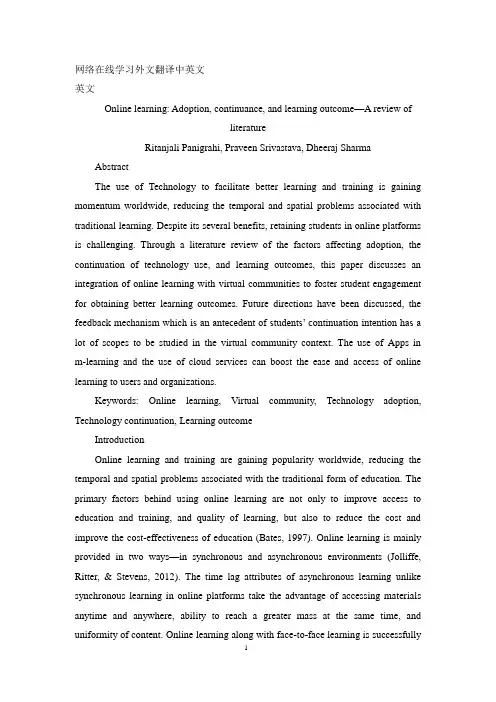
网络在线学习外文翻译中英文英文Online learning: Adoption, continuance, and learning outcome—A review ofliteratureRitanjali Panigrahi, Praveen Srivastava, Dheeraj Sharma AbstractThe use of Technology to facilitate better learning and training is gaining momentum worldwide, reducing the temporal and spatial problems associated with traditional learning. Despite its several benefits, retaining students in online platforms is challenging. Through a literature review of the factors affecting adoption, the continuation of technology use, and learning outcomes, this paper discusses an integration of online learning with virtual communities to foster student engagement for obtaining better learning outcomes. Future directions have been discussed, the feedback mechanism which i s an antecedent of students’ continuation intention has a lot of scopes to be studied in the virtual community context. The use of Apps in m-learning and the use of cloud services can boost the ease and access of online learning to users and organizations.Keywords: Online learning, Virtual community, Technology adoption, Technology continuation, Learning outcomeIntroductionOnline learning and training are gaining popularity worldwide, reducing the temporal and spatial problems associated with the traditional form of education. The primary factors behind using online learning are not only to improve access to education and training, and quality of learning, but also to reduce the cost and improve the cost-effectiveness of education (Bates, 1997). Online learning is mainly provided in two ways—in synchronous and asynchronous environments (Jolliffe, Ritter, & Stevens, 2012). The time lag attributes of asynchronous learning unlike synchronous learning in online platforms take the advantage of accessing materials anytime and anywhere, ability to reach a greater mass at the same time, and uniformity of content. Online learning along with face-to-face learning is successfullyused in industry as well as academia with positive outcomes (Chang, 2016). The geographically distributed team in an organization can get their skill training through online platforms at the same time, gaining a greater level of competitiveness. Online learning is also beneficial for students as they can learn at their own pace with the availability of online materials. The e-learning market is becoming popular and widely adopted by the education sector and industry. The growth of the e-learning market can be demonstrated by the fact that the global e-learning market is expected to reach 65.41 billion dollars by 2023 growing at a cumulative average growth rate of 7.07% (Research and Markets, 2018a). In addition to this, the global learning management system (LMS) is expected to increase from 5.05 billion USD in 2016 to 18.44 billion USD by 2025 growing at a rate of 15.52% (Research and Markets, 2018b).Despite several advantages of online learning such as improving access to education and training, improving the quality of learning, reducing the cost and improving the cost-effectiveness of education, retaining students in such platforms is a key challenge with a high attrition rate (Perna et al., 2014). Several strategies such as briefing, buddying, and providing feedback on the platform are proposed to retain and engage students (Nazir, Davis, & Harris, 2015). It is also noted that more self-discipline is required by students in online education, unlike traditional classroom education (Allen & Seaman, 2007). Keeping users enrolled and engaged is a challenging job as a personal touch by the instructor is missing or limited. The learning engagement which is an important antecedent for learning outcome is lower for technology-mediated learning than face-to-face learning (Hu & Hui, 2012). As a higher amount of money is spent on infrastructure, staff training, etc., organizations seek to take maximum benefit from online learning which requires an understanding of the factors that drive the adoption, continuation intention, and learning outcome of users on online learning platforms. Therefore, the primary focus of research remains on how to retain online learning users, and increase the efficiency of the online learning.Users may learn inside and outside the classroom; inside classroom learning isthrough instructors either from face-to-face, pure online or blended learning (combination of face-to-face and pure online learning) whereas outside classroom learning is conducted by users anytime and anywhere after the class. The exponential growth of the Internet has enabled individuals to share information, participate, and collaborate to learn from virtual communities (VC) anytime and anywhere (Rennie & Morrison, 2013). In a virtual community, people do everything that they do in real life but leaving their bodies behind (Rheingold, 2000). Virtual communities keep its users engaged based on familiarity, perceived similarity, and trust by creating a sense of belongingness (Zhao, Lu, Wang, Chau, & Zhang, 2012). It is essential to assess the role of a less constrained informal mode of learning (Davis & Fullerton, 2016) like virtual communities in the formal learning to engage and retain students.DiscussionGetting a new idea adopted even when it has obvious advantages is often very difficult (Rogers, 2003). Consistent with the previous statement, despite the advantages of online learning such as improving accessibility, quality, and reducing cost, it has a long way to go to be adopted and used by organizations because of the resistance at different levels (Hanley, 2018). The reasons for resistances offered by the employees in an organizations include perceived poor focus of the e-learning initiative, lack of time to learn new way of working, too much effort to change, lack of awareness, and resistance to change (Ali et al., 2016; Hanley, 2018). It is crucial from an institutional point of view to overcome the resistance to adopt and implement the online learning systems successfully.Understanding the factors of online learning adoption, continuation use intention, and learning outcomes are vital for an e-learning platform providing organization because the success of the platform depends on the successful adoption, continuation use, and finally achieving the desired outcomes. From the literature, it is found that the national culture affects the adoption and moderates the relationship between variables of adoption and use. Therefore, the results of adoption and use of technology might differ in different counties with different cultural dimensions. At a broader level, the perceived characteristics of innovation (of online learning) such as relativeadvantage, compatibility, complexity, trialability, and observability play a significant role in adoption. At an individual level, the primary factors of adoption are the individual expectancies such as the perceived usefulness, perceived ease of use, perceived enjoyment, performance expectancy, effort expectancy, etc., and the external influences such as subjective norm, social norms, surrounding conditions, national culture, social network characteristic, etc. On the other hand, the primary factors of continuation of technology use are the experiences of the individuals in the technology such as satisfaction, confirmation, self-efficacy, flow, trust, we-intention, sense of belongingness, immersion, IS qualities, etc. The perceived usefulness and perceived ease of use are found to be vital for both the technology adoption and continuation use. This implies that the usefulness of the technology and how easy the technology to use determines the adoption and continuation of technology. Apart from these technology enablers, the platform providers should consider the technology inhibitors which negatively impact the acceptance of the technology. The factors of the learning outcomes such as self-efficacy, virtual competence, engagement, design interventions, etc. should be considered before designing and delivering the content in the online learning platform to achieve optimum learning outcomes. The learners’ intention to use full e-learning in developing countries depends on the lea rners’ characteristics, and learners’ adoption of blended learning (Al-Busaidi, 2013). Studies for example by Verbert et al. (2014) have shown that blended learning yields the best outcome in terms of grade when students learn in online collaborative learning with teacher’s initiation and feedback. On the contrary, some studies have shown that contents such as business games do not need the interaction with the instructor; in fact, they are negatively related to perceived learning (Proserpio & Magni, 2012). MOOC (Massive Open Online Course) users have organized face-to-face meetings to fulfill their belongingness or social connectedness as a part of their learning activity (Bulger, Bright, & Cobo, 2015). This indicates that not everyone is good with a digitized form of learning, and hence both face-to-face and online components should be integrated for better outcomes.Lack of human connection is one of the limitations of online learning (Graham,2006) which may reduce the satisfaction level. To address this limitation, personalization functions of e-learning systems began. The satisfaction level, perceived and actual performance, self-efficacy scores increase in personalized online learning where learning materials are provided according to the cognitive capability and style of each individual (Xu, Huang, Wang, & Heales, 2014). Although personalization of e-learning systems is beneficial, they are socially and ethically harmful, and special attention should be given to issues such as privacy compromisation, lack of control, the commodification of education, and reduced individual capability (Ashman et al., 2014). Personal e-learning systems collect user information to understand the users’ interests and requirements for the learning which violates the privacy of individuals. The system utilizes the user information to show the personal content where the individuals do not have control over the learning content. Hence they are limited to certain personal contents which reduce their individual capabilities.Studies, for example, Zhao et al. (2012) have shown that VCs create a sense of belongingness and keeps the members engaged which results in improving the learning outcome, and users with same age groups are less likely to attrite (Freitas et al., 2015). Studies have shown that engagement is promoted when criteria such as problem-centric learning with clear expositions, peer interaction, active learning, instructor accessibility and passion, and using helpful course resources are met (Hew, 2015). Social interactions through social networking produce an intangible asset known as social capital (Coleman, 1988) in terms of the trust, collective action, and communication. Social capital is positively related to online learning satisfaction in group interactions, class interactions, learner-instructor interactions, as well as increasing students’ e-learning performance in groups (Lu, Yang, & Yu, 2013).The continuous development of mobile technology has expanded the opportunity to learn from mobile devices anywhere, anytime. M-Learning is much more beneficial for accessing education in remote areas and developing countries. The success of M-learning in organizations depends on organizational, people, and pedagogical factors apart from technological factors (Krotov, 2015). A range of mobiletechnologies such as laptops, smartphones, and tablets are embraced by students to support informal learning (Murphy, Farley, Lane, Hafeez-Baig, & Carter, 2014). Learning through mobile devices poses both opportunities as well as challenges; it provides flexibility in learning, on the other hand, it is a limitation for those who do not have connectivity and access to these devices. In student-centered learning especially collaborative and project-based learning, the use of mobile devices can be promoted by the mobile apps (Leinonen, Keune, Veermans, & Toikkanen, 2014). The use of mobile apps along with guidance from teachers integrates reflection in the classroom learning (Leinonen et al., 2014).Cloud computing provides organizations with a way to enhance their IT capabilities without a huge investment in infrastructure or software. The benefits of cloud computing are low cost, scalability, centralized data storage, no maintenance from user side (no software needed), easy monitoring, availability and recovery, and the challenges include it requires fast and reliable internet access, and privacy and security issues (El Mhouti, Erradi, & Nasseh, 2018). The primary factors for adoption of cloud computing in e-learning are ease of use, usefulness, and security (Kayali, Safie, & Mukhtar, 2016). Private cloud inside educational institutes can acquire the additional benefits in non-compromising the security and data privacy concerns associated with cloud computing (Mousannif, Khalil, & Kotsis, 2013). Cloud computing provides support to the online learning platforms to store and process the enormous amount of data generated. The problem of managing the increasing growth of online users, contents, and resources can be resolved by using cloud computing services (Fernandez, Peralta, Herrera, & Benitez, 2012).Future directionsFuture directions of research in online learning are as follows: First, the feedback mechanism used in online learning in institutions has not been used to measure the continuation intention in VCs. Feedback enables learners to define goals and track their progress through dashboard applications to promote awareness, reflection, and sense-making (Verbert et al., 2014). The students who received teachers’ feedback along with online learning achieved better grades than those who did not receivefeedback (Tsai, 2013) and students positively perceive the feedback systems more than the educators (Debuse & Lawley, 2016). Although immediate feedback is one of the dimensions of the flow (Csikszentmihalyi, 2014), the factor has not been studied in a VC context. It is vital for managers to check if feedback on a community post fosters the members’ continuation intention, and they should design user interfaces which encourage providing feedback. Second, it is high time to develop an integrated model for formal learning (online and blended) with VCs for students’ engagement. Informal learning as itself, not limited to the body of knowledge, rather, is the result of the interaction of people via communities of practice, networks, other forms, etc. (Rennie & Mason, 2004). The networked communities build intimacy and support which helps in self-directed learning (Rennie & Mason, 2004) which is an important parameter for online learning. Community commitment (Bateman et al., 2011), immersion (Shin et al., 2013), we-intentions (Tsai & Bagozzi, 2014), sense of belongingness (Zhao et al., 2012), etc. from the VC would help students to continue the engagement for a better learning outcome. Moreover, it is found that collaborative chat participation in MOOCs slows down the rate of attrition over time (Ferschke, Yang, Tomar, & Rosé, 2015). It is of great importance to check if learning outcome improves when the virtual community is integrated or embedded in the learning environment (online and blended). The educators and managers should encourage their students and employees to participate in VCs. Third, the growth of the adoption of mobile devices has expanded the arena of e-learning platforms. Integrating the virtual communities via a mobile platform with online learning can foster the student engagement resulting in higher learning outcome. Fourth, cloud computing has great potential in dealing with the scalability issues arising from the rise in numbers of users, content, and resources in online learning. Furthermore, it can provide tremendous benefits to organizations as well as users in terms of ease of access, flexibility, and lower cost. Although a few studies cover cloud computing infrastructure in education and pedagogic processes, the empirical research on the cloud computing for education is very shallow (Baldassarre, Caivano, Dimauro, Gentile, & Visaggio, 2018). As the mobile devices are often limited by storage space,future researchers are invited to carry out effective research on the integration of cloud computing and mobile learning to understand the factors affecting learning outcome.ConclusionUnderstanding the antecedents of e-learning adoption, continuance, and learning outcomes in online platforms are essential in ensuring the successful implementation of technology in learning and achieving the maximum benefits. This study shows factors such as PU, PEoU, PE, culture, attitude, subjective norms, system and information inhibitors, etc. contribute to the adoption of technology. Factors such as satisfaction, confirmation, user involvement, system quality, information quality, feedback, self-efficacy, social identity, perceived benefits, etc. determine the continuation of technology use. This implies factors for adoption, and continuation intentions vary; the attitude and usefulness of a system are essential for adoption while the experience and satisfaction in the environment lead to continuation intention. It is also found from the literature that the learning outcomes depend on the self-efficacy, collaborative learning, team cohesion, technology fit, learning engagement, self-regulation, interest, etc.The contribution of the paper can be summarized as: understanding the factors that are studied for adoption, continuance, learning outcomes in an online environment, and the provision of future research directions for educators and managers for successful implementation of technology in online platforms to achieve maximum benefits.中文在线学习的采用,持续性和学习成果:文献综述摘要在全世界范围内,使用技术促进更好的学习和培训的势头正在增强,减少了与传统学习相关的时空问题。
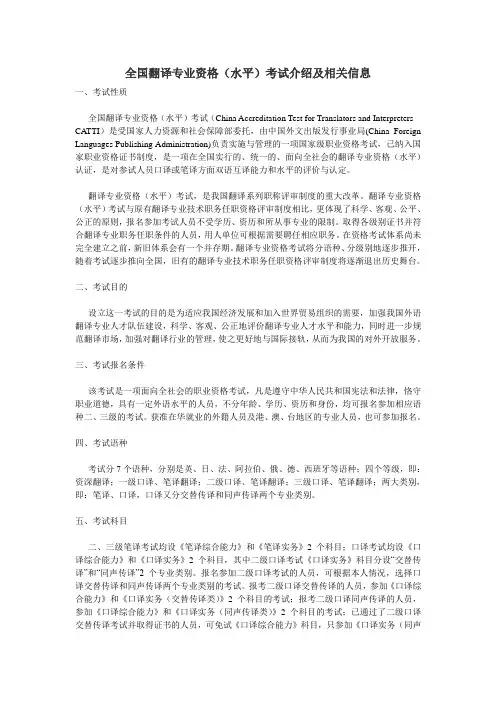
全国翻译专业资格(水平)考试介绍及相关信息一、考试性质全国翻译专业资格(水平)考试(China Accreditation Test for Translators and Interpreters -- CA TTI)是受国家人力资源和社会保障部委托,由中国外文出版发行事业局(China Foreign Languages Publishing Administration)负责实施与管理的一项国家级职业资格考试,已纳入国家职业资格证书制度,是一项在全国实行的、统一的、面向全社会的翻译专业资格(水平)认证,是对参试人员口译或笔译方面双语互译能力和水平的评价与认定。
翻译专业资格(水平)考试,是我国翻译系列职称评审制度的重大改革。
翻译专业资格(水平)考试与原有翻译专业技术职务任职资格评审制度相比,更体现了科学、客观、公平、公正的原则,报名参加考试人员不受学历、资历和所从事专业的限制。
取得各级别证书并符合翻译专业职务任职条件的人员,用人单位可根据需要聘任相应职务。
在资格考试体系尚未完全建立之前,新旧体系会有一个并存期。
翻译专业资格考试将分语种、分级别地逐步推开,随着考试逐步推向全国,旧有的翻译专业技术职务任职资格评审制度将逐渐退出历史舞台。
二、考试目的设立这一考试的目的是为适应我国经济发展和加入世界贸易组织的需要,加强我国外语翻译专业人才队伍建设,科学、客观、公正地评价翻译专业人才水平和能力,同时进一步规范翻译市场,加强对翻译行业的管理,使之更好地与国际接轨,从而为我国的对外开放服务。
三、考试报名条件该考试是一项面向全社会的职业资格考试,凡是遵守中华人民共和国宪法和法律,恪守职业道德,具有一定外语水平的人员,不分年龄、学历、资历和身份,均可报名参加相应语种二、三级的考试。
获准在华就业的外籍人员及港、澳、台地区的专业人员,也可参加报名。
四、考试语种考试分7个语种,分别是英、日、法、阿拉伯、俄、德、西班牙等语种;四个等级,即:资深翻译;一级口译、笔译翻译;二级口译、笔译翻译;三级口译、笔译翻译;两大类别,即:笔译、口译,口译又分交替传译和同声传译两个专业类别。
A NOVEL WEB-BASED ONLINE EXAMINATIONSYSTEM FORCOMPUTER SCIENCE EDUCATIONYuan Zhenming1, Zhang Liang2, Zhan Guohua3AbstractWeb-based Examination System is an effective solution for mass education evaluation. We have developed a novel online examination system based on a Browser/Server framework which carries out the examination and auto-grading for objective questions and operating questions, such as programming, operating Microsoft Windows, editing Microsoft Word, Excel and PowerPoint, etc. It has been successfully applied to the distance evaluation of basic operating skills of computer science, such as the course of computer skills in Universities and the nationwide examination for the high school graduates in Zhejiang Province, China.1. WEB-BASED ONLINE EXAMINATION SYSTEM1.1The aim of the examination systemAs a universal examination system for the education of basic computer operation, it must meet the following requirements:1. A reasonable question storage, which must conform to the general outline of the exam.2. A practical interface. There are two types of exam interfaces. One is the simulation, the other is the actual environment. The second scheme will give the student computer skills.3. A range of question types, such as objective questions, operating questions, design questions, information retrieval, group testing, etc.4. A safety and reliable examination system.1.2 The components of WOESThe Web based Online Examination System (WOES) is a multi-layer system which is composed of the Web Server, Database Server, and WOES middleware Server, WOES client module and Browser, such as Internet Explorer. In this system, we use the Internet Information Server 4.0(IIS) as the Web Server, the Database Server is Microsoft SQL Server 7.0.The kernel of WOES is the WOES middleware Serve and the WOES client module, which is designed according to Microsoft DCOM standards. DCOM is the binary COM object’s extension jointing LAN, WAN and Internet, which can instance and bind objects over different network. It is an advanced network protocol used to cooperate with COM based components of two processes in different locations. The WOES middleware Server is a server-side component The WOES middleware Server is a server-side component providing communication interfaces between WOES clients and the Web Server or Database Server. The WOES client is a client-side component, which is called by the Browser to control the client computer and submit or receive information from the WOES Server. This technology guarantees the flexibility and the potential for extension of the test system. In addition, it allows access to local files, whereas in conventional systems, the IE security prevents such access.1.3 The key technologies of WOES1. A user-friendly interfaceWe use br owser as our user’s interface. The Browser interface has a uniform and consistent user interface. Almost everyone is able to use it skillfully. Therefore it can eliminate the differences of various exam systems and guarantee a fair test.2. Simplified system maintenanceSince the system is based on Browser/Server architecture, the teacher can update the system or the question database o examine the student’s database only in Server. It is not necessary to update the client system as the Client/Server must do.3. Central examination managementProfiting from the central controlled system, the teacher can easily control the examination process, such as the beginning and end of the exam, collecting the answers and monitoring the students’ conditions on the te acher’s screen.4. SecurityThe most severe difficulty which the B/S based system faces is security, because in principle the web-based examination system can be accessed on the Internet or WAN in a city.All the questions, materials and answers are transmitted in bits stream format after encoding, not in file format. It can ensure not only security in the transmission process, but also protect from invasion.When one student starts his test, the system will distribute him a password produced according to his client’s hardware and operation system environment. It can prevent cribbers to login from other clients imitating this student.The newest method to prevent the distant student from leaving the client or is making use of face detection and recognition technology. Before the start of the exam, the student is asked to sit in front of thecomputer camera, which can monitor the whole scene. Then the system will automatically recognize the student’s face and his identification. As soon as the validation is performed, the student must stay in front of the camera until the exam is finished.2. AUTO-GRADING SYSTEMThe auto-grading system can automatically grade the answers, which are collected from the examination system. It helps teachers to achieve the score with ease.There are two types of the grading: objective questions and operating questions. Objective questions, such as choice questions, yes/no questions, and fill-in questions, can be graded effectively by accurate matching or fuzzy matching. But it is difficult to grade operating questions by simple matching technologies.A possible solution could be: Reading the answer file directly and comparing it to the key file. But this is not practical because the format of Microsoft Office files is complicated.Another solution is: (2) grading by using the Office OLE object. This method is convenient and efficient, but it has a big disadvantage: the source code of the grading system is closely related to the concrete question, which results in a large amount of work when the questions are changed.We propose a universalized grading system, which is carried out on the basis of a database of key knowledge.First, we extract all possible knowledge points and store them in a triple form: (key, value, location). Then we produce the question file by labeling the question point directly on it; the system will add the corresponding question key to the standard key library. So, the last process of auto-grading system is to compare the answer file with the standard key library. The auto-grading system also allows the teacher to add his /her own questions to our examination system.3. CONCLUSIONWe have developed an overall solution to the examination system for practical computer skills. It provides a user- friendly platform of various questions for the basic computer education in Universities. Hundreds of thousands of students and teachers have used this system and agree that it has effectively raised the learning and testing efficiency.一种新型的基于web的在线考试系统Yuan Zhenming1, Zhang Liang2, Zhan Guohua3摘要基于web的在线考试系统是大众教育评估的一种有效解决方法。
目录一、Analysis of function requirement (2)1 .1Introduction (2)1.2 Use (2)1.3 Operating Environment (5)1.4 The process of using (5)二、Description of technology framework (7)2.1 FRAMEWORK (7)2.2 B/S structure and XML (8)三、Detailed design (9)3.1 General framework design(总体架构设计) (9)3.2 project pictures including the packages and classes. (9)3.3 UML for project, including class diagram, use case and sequence diagram. (14)3.4 Database design. (22)3.5 XML design (25)四、Test (28)4.1 The test strategy (28)4.2 The test cases, include black-box testing, white-box testing and gray-box testing. (37)4.3 Test extreme data (37)五、Analysis of the tough technology and features (38)5.1 xml (38)5.2 eXist (39)5.3 JavaBean (40)5.4 Jquery (40)5.5 Ajax (41)六、Summary about the project and the course (41)七、Appendix (42)7.1 CreateXMLFile (42)7.2 SearchXML (43)7.3 UpdateOperate (48)八、References (54)一、Analysis of function requirement1 .1Introduction1.1.1 The purpose of user's manualThe purpose of this users' manual is to enable users to know more clearly about our system and facilitate the users’ operation. The targeted readers are common users but not experts.1.1.2 BackgroundExplanation:a.Project Name:Pigeon News Publishing System;b.Task author:hao Lic.researchers:Ji JiaXiong,Lin LeiLei,Li XueYun,Zeng Qi;d.Test user:Ji JiaXiong,Lin LeiLei,Li XueYun,Zeng Qi;1.1.3DefinitionMysql----- Open-source Relational databaseeXist-db ------ eXist-db is an open source database management system built using XML technology. It stores XML data according to the XML data model andfeatures efficient, index-based XQuery processing.Xquery-----An XML Query Language;Xpath-------XML Path Language (XML Path Language), which is an XML document used to determine the location of a part of thelanguageJquery----Is a cross-browser JavaScript library, and strengthen the operation between the HTMLand JavaScriptIDE------ also known as integrated design environment or integrated debugging environment is a software application that provides comprehensive facilities to computerprogrammers for software development.1.2 Use1.2.1 Functiona.Function:a)web developer:For users to browse, manipulate, test, the exam, course selection,registration account。
在线考试系统(OnlineExamSystem) ⽤户设计-|学⽣-|⽼师-|管理员学⽣结构设计-|个⼈信息管理-|修改个⼈信息-|修改登录密码-|选课中⼼-|显⽰所有⽼师所开课的信息可进⾏选课-|显⽰⾃⼰已选课程-|在线考试-|对已选⽼师开设的课程选择进⾏考试-|成绩查询-|查看⾃⼰考试成绩⽼师结构设计-|个⼈信息管理-|修改个⼈信息-|修改登录密码-|课程管理-|显⽰学校开设的课程(⽼师可选择添加课程)-|显⽰⽼师开设的课程-|考试管理-|显⽰⽼师⾃⼰开设的课程-|对课程添加试题(选择、填空、简答)-|查看所开设课程的考试信息(查看该课程学⽣考试情况)管理员结构设计**-|初始教师信息(写⼊⽼师编号,⽼师根据编号才能注册)-|初始课程信息(写⼊课程信息,⽼师可选择课程进⾏开设)数据库⽀撑:管理员表⽼师表学⽣表选择题表 XZe_yi存放正确答案,在前台进⾏调整选项,减少数据冗余。
XZe_Type:该选择题属于哪个科⽬,直接写课程ID。
XZe_Zl:是真题还是练习题。
XZe_Zj:题⽬章节。
填空题表这⾥TK_k1, 该题第⼀个空的答案,TK_k2 第⼆个空的答案,类推【这⾥TK_F字段,判断这⼏个答案是否可以乱序回答,例如,请说出四书是那四书,那么此时的答案可能是乱序的。
答辩时碰到导师问道这个问题//0.0,后加上的】简答题表课程表⽼师选课表学⽣选课表界⾯⽀撑:其他页⾯不在展⽰......总结点(⼤⽜勿喷):在本次实训中,对学过的进⾏了实践,个⼈感觉关键点:对整体考试系统的把握、数据库的分析与创建、在线考试页⾯的技术⽀撑。
再细⼀点,整个系统运⾏的流程,三个不同⾓⾊的功能。
数据库表的分析,尽量的“优”。
各个页⾯技术的实现细节。
整个系统不再赘述。
数据库要分析好【如果读者觉得本次数据库设计还有什么好的意见请留⾔博主,先谢谢】。
各页⾯技术的实现。
在线考试页⾯,设计细节:附加函数:1public Random a = new Random();//对试卷选项进⾏排序⽣成随机顺序2public int[] PaiXu() //随机排序,返回⼀个整形数组,长度为4,值为3 4 5 6,不确定值的顺序,⽤于选择题的选项排序3 {4int[] i = new int[4];56 i[0] = a.Next(3, 6);7switch (i[0])8 {9case3: i[1] = a.Next(4, 5); i[2] = 6; i[3] = 9 - i[1]; break;10case4: i[1] = a.Next(5, 6); i[2] = 3; i[3] = 11 - i[1]; break;11case5: i[1] = a.Next(3, 4); i[2] = 7 - i[1]; i[3] = 6; break;12case6: i[1] = a.Next(3, 4); i[2] = 5; i[3] = 7 - i[1]; break;13 }14return i;15 }16页⾯代码:1using System;2using System.Collections;3using System.Configuration;4using System.Data;5using System.Linq;6using System.Web;7using System.Web.Security;8using System.Web.UI;9using System.Web.UI.HtmlControls;10using System.Web.UI.WebControls;11using System.Web.UI.WebControls.WebParts;12using System.Xml.Linq;13using MySql.Data.MySqlClient;14using DB_;1516public partial class student3 : System.Web.UI.Page17 {18static int[] da = new int[6];//存放答案 xz19int daa = 0;//记录第⼏条 ,答案选项0123 xz20public static string[,] tkda = new string[10, 3];//存放答案 tk 最多⼗条填空,3⽤来标识关键字只有k1-k321public static string[,] jdda = new string[10, 6];//存放答案 jd 同填空题22 DB db = new DB();//创建对象23//------24//⽣成试卷选择5 50 填空5 25 简答题 2 2525//26int xzt = 5, tkt = 5, jdt = 2, xzf = 50, tkf = 25, jdf = 25;27int jdcj = 0, tkcj = 0, xzcj = 0;28static int tkkk = 0;//填空题记录有⼏个空填空29static string Kid = "", Tid = "";30protected void Page_Load(object sender, EventArgs e)31 {32try33 {3435if (!IsPostBack)36 {37if (Request["kid"] != null && Request["tid"] != null)38 {39 Kid = Request["kid"].ToString();40 Tid = Request["tid"].ToString();41 }42 XZZ();43 TKK();44 JDD();45 }46 }47catch48 { Response.Write("<script>alert('载⼊有误请重新登录!');window.location.href='Login.aspx';</script>"); }495051 }52protected void XZZ()53 {54// MySqlConnection con=null;55try56 {57int tm = 1;58string sqlstr = "SELECT * from XZe_ where XZe_Type='"+Kid+"' and XZe_TeaId='"+Tid+"' order by rand() limit "+xzt; 59// con = db.conntent();60 MySqlDataReader selectcom = db.Select1(sqlstr);//, con61while (selectcom.Read())62 {63 Label j1 = new Label();64 RadioButtonList i1 = new RadioButtonList();65//i1.ID = js.ToString();66 j1.Text = tm.ToString()+". "+selectcom.GetString("XZe_T");//题⽬67 tm++;//1. 2. 3.68int[] a1 = new int[4];//存放随机结果 a[0-3]=>3-669 RepeatDirection Horizontal = new RepeatDirection();//设置单选按钮组为横排70 i1.RepeatDirection = Horizontal;//设置单选按钮组为横排+7172 a1 = db.PaiXu();//使⽤排序得到随机的345673for (int j = 0; j < 4; j++)74 {75if (a1[j] == 3) { da[daa++] = j; }76 ListItem a22 = new ListItem();//建⽴列表组77 a22.Value = j.ToString();//⽤于取出value 值与答案⽐较78 a22.Text = selectcom.GetString(a1[j]);//将数据付给listItem 对象79 i1.Items.Add(a22);//添加数据到列表项80 }81 XZ.Controls.Add(j1);82 XZ.Controls.Add(i1);83 }84 }85catch(Exception e) { Response.Write("取数据有错误"); }86finally { }8788 }89protected void TKK()90 {91 tkkk = 0;92int a = 0;93string sqlstr ="SELECT * from tk_ where TK_Type='"+Kid+"' and TK_TeaId='"+Tid+"' order by rand() limit "+tkt;94 MySqlDataReader selectcom = db.Select1(sqlstr);95while (selectcom.Read())96 {97for (int j = 0, i = 3; i < 6; i++)//数据库中答案字段 3-698 {99 tkda[a, j++] = selectcom.GetString(i);100 }101 Label j1 = new Label();//存放题⽬102string abc = selectcom.GetString("TK_T");103string[] arr = abc.Split('_');//⽤ _ 来分割有⼏个空104 j1.Text = "<br />"+ (++a).ToString()+"."+selectcom.GetString("TK_T")+"<br />";//题⽬105 TK.Controls.Add(j1);//添加题⽬到⽹页中106for (int i = 0; i < arr.Length - 1; i++)107 {108 tkkk++;109 TextBox q = new TextBox();110 TK.Controls.Add(q);111//⽣成相应的填空112 }113 }114 }115protected void JDD()116 {117int j = 0;118string sqlstr = "SELECT * from jd_ where JD_Type='" + Kid + "' and JD_TeaId='" + Tid + "' order by rand() limit "+jdt;119 MySqlDataReader selectcom = db.Select1(sqlstr);//, con120while (selectcom.Read())121 {122123for (int a = 0, i = 3; i < 9; i++)124 {125 jdda[j, a++] = selectcom.GetString(i);//i⽤来取数,a⽤来写⼊数组,j⽤来表⽰第⼏条数据126 }127 Label j1 = new Label();//存放题⽬128 j1.Text = "<br />"+ (++j).ToString()+"."+selectcom.GetString("JD_T")+"<br />";//题⽬129 TextBox a1 = new TextBox();130 a1.TextMode = TextBoxMode.MultiLine;///设置⽂本框为多⾏输⼊131 a1.Rows = 4;//设置⽂本框的⾏数132 JD.Controls.Add(j1);//添加题⽬到⽹页中133 JD.Controls.Add(a1);//添加⽂本框134 }135 }136protected void LOOK_Click(object sender, EventArgs e)137 {138 XZCJ(); TKCJ(); JDCJ();139int zz = xzcj + tkcj + jdcj;140string cjj = "insert into xsks_ values('"+Session["id"]+"','" + Tid + "','" + Kid + "',CURDATE( ),'" + zz + "')";141if (db.ZSG(cjj)) { Response.Write("<script>alert('成绩提交成功!你的成绩是 "+zz.ToString()+"');window.location.href='students.aspx'</script>"); } 142else{ Response.Write("<script>alert('成绩提交失败!');</script>"); }143 }144protected void XZCJ()145 {146int j = xzt, i = 0;147try148 {149while (i < xzt)150 {151int xzx = Convert.ToInt32(Request.Form[j++].ToString());//*得到选择项152if (da[i++] == xzx)153 xzcj += (xzf / xzt);154 }155156 }157catch158 {159160 }161 }162protected void TKCJ()163 {164165int xx = xzt*2;166try167 {168for (int i = 0; i < tkt; i++)169 {170for (int j = 0; j < 3; j++)171 {172if (tkda[i, j] == "") continue;173if (tkda[i, j] == Request.Form[xx++].ToString())174 tkcj += (tkf / tkkk);175 }176 }177178 }179catch180 {181182 }183 }184protected void JDCJ()185 {186187int xx = 2*xzt+tkcj;188try189 {190for (int i = 0; i < tkt; i++)191 {192for (int j = 0; j < 6; j++)193 {194if (jdda[i, j] == "") continue;195if (Request.Form[xx].ToString().IndexOf(jdda[i, j]) + 1 >= 1) 196 { if (jdcj < (jdf / jdt))jdcj += 3; else break; }197 }198 xx++;199 }200201 }202catch(Exception e)203 { }204205 }206 }该项⽬已被学姐要⾛。
附录Based on B/S ETAS on-line test system deliberatingBased on B/S ETAS on-line test system deliberating Along with the computer and its the network technology rapid development and the social information level unceasing enhancement, the computer surveyed and appraises the process also to obtain the widespread application in the education. The computer assistance appraisal in the education, the teaching and in the study appraisal process application, has initiated the appraisal content, the method and the form profound transformation. The development, the application can gather the education to evaluate after testing the theory, the method and the modern information technology method on-line evaluates after testing the system, provides for the student individuality study "nimble, convenient, scientific, is fair" "individually melts the study to evaluate after testing the service", has become the education front specially is a important task which the general distance learnings worker faces.Has developed distance learning 20 for many years, has obtained the rich experience in the distance learning aspect, receives the Ministry of Education and the education profession highly takes. Since in 1999, the development "the talented person raise pattern reform and the opening have educated the experiment site" the project, on the one hand positively explores teaching aspect the and so on management pattern, teaching method, teaching method reform, simultaneously also positively is developing the curriculum to evaluate after testing the way the reform, adapts the distance learning development as well as the talented person raise pattern reform and the opening educates the experiment site the need. Therefore, has developed "the on-line test system".The ETAS on-line test system has fully manifested the open design thought. The system not only can load bearing each kind of curriculum (or has custom-made inspection content, like each kind of non- school record education training) the question bank, the volume storehouse or the single wrap examination paper, the implementation curriculum (or has custom-made inspection content) test. Thequestion bank, the volume storehouse or the single wrap examination paper may carry on maintenance as necessary and so on increase, deletion, revision; The data transmission support many kinds of ways, in the network unobstructed situation may through the Internet direct transmission, also may the data which is going to transmit after the network not unobstructed situation pack the encryption to progress the good data transmission the copy to each kind of storage device; The teacher (or appraisal) and the study may register in the certain jurisdiction every time; The system support many kinds of registers for the way, including on-line registers for, the examination site registers for, the single registers for, the batch inducts, the test registration nimble is convenient.The test system evaluates after testing the system since, also is long-distance evaluates after testing the management system management system. Its design based on the graduation school, the level-to-level administration management mechanism, uses the multistage system constitution. The central administrative center is the overall system control center, the provincial level administrative center is this system data relay and the processing center, the examination site is the systematic most basic unit, is directly organizes the examinee to carry on the registration, the test, the collection information terminal. All levels of systems may increase the test content under the certain condition, carries on in the assignment jurisdiction the test organization, simultaneously, the collection formulation test plan, the examinee registration, the examination place arrangement, the examination place management, the examinee take a test, examines test papers with flow and so on result output issue is a body, has had the distance learning management function. These functions realizations enable this system to have the superiority which the campus on-line test system did not have.The system formulation test plan nimble is convenient, can assign the test the time, the test subject, the test use question bank or the volume storehouse, as well as inspection content and test question difficulty and so on; In order to achieve the test secure request, the data encryption uses the multistage encryption the way, defined the question bank and the volume storehouse only can open a time in the test process, strengthened the question bank secrecy. The system broke through the most computers test system topic to be unitary also only to have the objective test question the shortcoming, supported the many kinds of test questions type, the objective test question including the list selected topic, the multi- selected topics, the choice filledup the topic, the judgement topic, fills up the topic, the subjective test question included: The large-scale idea mathematics problem, the medium idea mathematics problem, the small idea mathematics problem, the elaboration topic, Jan answer, the case analysis topic, the solid service topic, the synthesis synthesis. Moreover, but also may hang meets like the IT kind of curriculum simulation experiment, greatly strengthened the system extension and the usability. The system use test question attribute expressed between the test question relations, the test question attribute has the incompatible topic, contains the topic, the smooth topic and so on, scientifically causes the group volume to be effective. The system use knowledge spot, the difficulty, the discrimination, the exposure time many kinds of parameters control test question, carries on the science the group volume, also guarantees the test fairness, also effectively prevented the student cheats the behavior occurrence. The system grades, the objective test question automatically comments reads, the subjective test question transmission comments reads the center to comment reads, and can carries on passing an examination rate to the examinee and the test question, cheats the situation, lacks tests the situation, the result section distribution, test question responding rate and so on the many kinds of statistical analysis, forms to the teaching effective feedback. Considers the examination place partial software and hardware environment the non- unity, but the examination place are partial also is the test important link, the reliability is the system design priority target, in the system uses the data backup machine to preserve all examinees' test result, guaranteed student's test machine in the power cut, dying machine and so on in the situation, can restore to the normal test condition, guaranteed examinee's test data cannot lose.After the system development completes, first has carried on the experiment site in the Beijing TV University. January 15-18, 2003, the Beijing TV University has carried on the WTO knowledge course curriculum test using the test system, altogether had 1,081 people to participate in the test, has supposed three examination places (engine room), has carried on 45 tests. The test carries on very smoothly, does not have any exceptionally.After the Beijing TV University experiment site, starts in the TV University system promotion use, the selection curriculum to cover the region to be broad, but reference population relative less "accounting" and "business management" specialized degree English curriculum. In June 28 on 29th, "business management" and "accounting" specialized degree English on-line test official hold. 42 TVUniversity 180 examination site, 440 numbers of showings, 12,063 people participate in the test, because the entire day power cut, the subordinate branch school outside examination site except the Guangdong Zhongshan examination site because the examination place is unable to induct the examination site arrangement test not to complete, other examination site all quite smoothly have completed the test. On December 7 on 8th, saved the school, 135 examination site, 11,215 examinees in 44 has carried on the second degree test, did not have any exceptionally.After the test had ended, each measure unit to be used believed, ETAS on-line test system design thought advanced, system various modules function complete, movement safe reliable, the operation is simple. The on-line test overcame the traditional test malpractice, the examinee has stochastically obtained the test question on the computer, completed the test, substituted formerly took a test sets the topic of a composition, printing, delivered the topic, the test, receives the volume, grades, ascends classifies a series of operating process, caused the test process to change conveniently, is highly effective, quickly, simultaneously also reduced the test cost, was worth promoting the application.After the test the examinee responded that, Through on-line carries on the test using the computer, provides nimbly for the student, convenient, scientific, is fair individually melts the test service, causes the student namely to namely is the possibility, extremely adapts the characteristic which the adult studies, they welcome very much.The ETAS on-line test system is in under the modern science fast development new situation, for adapts a collection modern distance learning theory, the method and the modern information technology method test system well which the modern distance learning evaluates after testing needs to promote. The system not only has the function which the campus on-line test system has, moreover also had has tested the service management function, fully has manifested the distance learning open characteristic. Its development and use, not only will play in our country distance learning test appraisal the vital role, moreover will have the significant influence to our country distance learning test reform. First, the test system widely is promoted in the TV University opening education school record education the application, takes the traditional written examination the supplement. At present already has completed 50 curricula small question banks, these curricula tests soon complete through the on-line test system; Along with our country economy development and the computerpopularization, it possibly replaces examines by writing, becomes the test the mainstream; Satisfies individually melts the need which the student takes a test, the student may independently choose the curriculum to study, participates in the test every time. Regarding because works the student which or other reasons cannot participate in the curriculum written examination, may complete through the on-line test system; Moreover, this system also will use in the social non- school record education curriculum and the profession authentication project test service; Specially, the test system may use in the Austria huge mythical bird distance learning service platform public service system, serves for our country distance learning curriculum test makes the contribution.Any new software system, always some gradually consummates the process, the ETAS on-line test system also so, at present also has some problems, for example: The system has not solved the examinee identification authentication problem; The question bank construction also must further consummate, the subjective topic test realization also needs to seek a more effective way and so on, unceasingly will develop in the network technology and the test theory today, the test system also further consummates in various aspects.译文基于B/S的ETAS网上考试系统的研讨随着计算机及其网络技术的飞速发展和社会信息化水平的不断提高,计算机在教育测量和评价过程也得到了广泛的应用。
J2EE文献及翻译1 引言本文分析了Hibernate和Struts的机制,提出了一种基于Hibernate和Struts 的J2EE应用开发策略。
在这种策略中,模型层用Hibernate实现,视图和控制器则用Struts框架实现。
这样可大大降低代码的耦合性以及提高系统的开发效率。
关键字Hibernate,Struts,MVC,持久层。
随着Java技术的逐渐成熟与完善,作为建立企业级应用的标准平台,J2EE平台得到了长足的发展。
借助于J2EE规范中包含的多项技术:EnterpriseJavaBean(EJB)、Java Servlets(Servlet)、Java Server Pages(JSP)、Java Message Service(JMS)等,开发出了许多应用系统。
但是,在传统J2EE 应用的开发过程中也出现了一些问题:1)数据模型和逻辑模型之间的矛盾。
目前使用的数据库基本上都是关系型数据库,而Java本质上是一种面向对象的语言,对象在存储和读取时使用SQL和JDBC进行数据库操作,降低了编程的效率以及系统的可维护性;2)传统的J2EE应用多采用基于EJB的重量级框架,这种框架适合于开发大型企业应用,但是使用EJB容器进行开发和调试需要耗费大量时间。
为了降低代码的耦合性,提高系统的开发效率,本文提出了一种基于Struts 框架和Hibernate框架的J2EE应用开发策略。
2 J2EE开源技术介绍数据持久层及Hibernate,Hibernate是一个数据持久层框架,是一种实现对象和关系之间映射(O/R Mapping)的工具,它对JDBC进行了轻量级的对象封装,使程序员可以使用对象编程思想来操作数据库。
它不仅提供了从Java类到数据表的映射,也提供了数据查询和恢复机制。
相对于使用JDBC和SQL来操作数据库,使用Hibernate能大大的提高实现的效率。
Hibernate框架用配置文件的形式来定义Java对象和数据表之间的映射关系,同时在更深的层面将数据表之间的关系解释为Java对象之间的继承及包含等关系。
通过使用HQL语句将复杂的关系算法用对象的方式描述,在很大程度上简化了对数据的查询,加快了开发的效率。
在Hibernate中有一个简单而直观的API,用于对数据库所表示的对象执行查询。
要创建或修改这些对象,只需在程序中与它们进行交互,然后告诉Hibernate保存即可。
这样,大量封装持久化操作的业务逻辑不再需要编写烦琐的JDBC语句,从而使数据持久层得到了极大的简化。
用Struts实现MVC架构MVC(Model-View-Controller)由Trygve Reenskaug提出,首先被应用在SmallTalk-80环境中,是许多交互和界面系统的构成基础。
根据界面设计可变性的需求,MVC把交互系统的组成分解成模型、视图、控制器三部分。
模型(Model)是软件所处理问题逻辑在独立于外在显示内容和形式情况下的内在抽象,封装了问题的核心数据、逻辑和功能的计算关系,独立于具体的界面表达和I/O操作。
视图(View)把表示模型数据及逻辑关系和状态的信息及特定形式展示给用户。
它从模型获得显示信息,对于相同的信息可以有多个不同的显示形式或视图。
控制器(Controller)是处理用户与软件的交互操作的,其职责是控制提供模型中任何变化的传播,确保用户界面于模型间的对应联系;它接受用户的输入,将输入反馈给模型,进而实现对模型的计算控制,是使模型和视图协调工作的部件。
通常一个视图对应一个控制器。
模型、视图与控制器的分离,使得一个模型可以具有多个显示视图。
如果用户通过某个视图的控制器改变了模型的数据,所有其它依赖于这些数据的视图都应反映到这些变化。
因此,无论何时发生了何种数据变化,控制器都会将变化通知所有的视图,导致显示的更新。
这实际上是一种模型的变化-传播机制。
Struts框架最早是作为Apache Jakarta项目的组成部分问世运做,它继承了MVC的各项特性,并根据J2EE的特点,做了相应的变化与扩展。
Struts框架很好的结合了Jsp,Java Servlet,Java Bean,Taglib等技术。
在Struts中,承担MVC中控制器角色的是ActionServlet。
ActionServlet是一个通用的控制组件。
这个控制组件提供了处理所有发送到Struts的HTTP请求的入口点。
它截取和分发这些请求到相应的动作类(这些动作类都是Action类的子类)。
另外控制组件也负责用相应的请求参数填充Action Form(FromBean),并传给动作类(ActionBean)。
动作类访问核心商业逻辑,即访问Java Bean或调用EJB。
最后动作类把控制权传给后续的JSP文件,由JSP文件生成视图。
所有这些控制逻辑利用Struts-config.xml文件来配置。
在Struts框架中,视图主要由JSP生成页面完成,Struts提供丰富的JSP标签库,这有利于分开表现逻辑和程序逻辑。
模型以一个或多个Java Bean的形式存在。
在Struts中,主要存在三种Bean,分别是:Action,ActionForm,EJB或者Java Bean。
Struts框架没有具体定义模型层的实现,在实际开发中,模型层通常是和业务逻辑紧密相连的,并且要对底层数据进行操作。
下面介绍一种开发策略,将Hibernate引入到Struts框架的模型层中,使用它来进行数据封装和映射,提供持久化的支持。
下面结合开发实践,以在J2EE应用中非常普遍的用户登录过程为例,来说明上述体系结构是如何具体运用的。
登录的流程非常清晰:用户从登录页面login.jsp输入登录信息,系统对登录信息进行验证,如果正确则成功登录,否则提示相应错误信息。
在开发过程中,使用Eclipse做为开发环境,同时加载了对Struts及Hibernate提供更好的控制和支持的第三方插件MyEclipse,Web服务器使用Tomcat,数据库选用了Mysql。
首先对Hibernate进行配置,只需要对系统自动生成的hibernate.cfg.xml进行修改,配置好数据库连接的各种参数以及定义数据映射文件。
由于Hibernate所带的连接池主要用于测试,性能不是很好,可以通过JNDI将其修改为使用Tomcat的连接池。
附件:外文资料原文J2EEAndrew Glover1 IntroductionThis text analysis the mechanism of Hibernate and Struts, put forward 1 kind EE according to the J2 of the Hibernate and the Struts application development strategy.In this kind of strategy, the model layer use a Hibernate realization and see diagram and controller to then use a Struts frame a realization.So can consumedly lower the development efficiency that the Ou of code match sex and exaltation system. The key word Hibernate, Struts, the MVC, hold out for long time a layer one preface along with the Java technique of gradual mature and perfect, Be establishment business enterprise class application ofstandard terrace, the J2EE terrace got substantial of development.Several technique asked for help from to include in the J2 EE norm:Enterprise JavaBean(EJB), Java Servlets(Servlet), Java Server Pages(JSP), Java Message Service(JMS).etc., development many application system.But, also appeared some problem in the tradition J2 the EE the application of the development the process: the antinomy of of data model and logic model.Currently the database of usage basically and all is relation type database, but the Java be essentially a kind of the language which face to object, object at saving with read usage SQL and JDBC carry on a database operation and lowered plait distance of efficiency and system of can maintenance; tradition of J2 EE application much the adoption is according to the EJB heavy weight frame, this kind of frame suitable for develop a large business enterprise application, but usage the EJB container carry on development and adjust to try to need to be waste a great deal of time.For lowering the Out of code to match sex, exaltation system of development efficiency, this text put forward 1 kind EE according to the J2EE of the Struts frame and the Hibernate frame application development strategy.2 Open Source Technology of J2EEDatas' holding out for long time layer and Hibernate is one piece according to hold out for long time layer frame, is a kind of realization object and relation of the tool which reflect to shoot(O/R Mapping), itcarried on the object of the lightweight to pack to the JDBC and make procedure member can usage object plait distance thought to operation database.It not only provided to shoot from Java to reflect of data form, but also provided a data a search and instauration mechanism.Opposite in usage JDBC and SQL to operation database, use a Hibernate ability consumedly of exaltation realization of efficiency.The Hibernate frame use allocation document of the form come to the reflect of the definition Java object and data form to shoot relation, in the meantime at more deep of level of data form of relation explanation for the relations such as inherit of and containment etc. of Java object.Pass the usage HQL language sentence complications of relation the calculate way use the way of object description, to a large extent simplification logarithms according to of search, speed development of efficiency.Have in the Hibernate a simple but keep the API of view, used for to the database mean of object performance search.Want to establish or the modification be these objects, need in the procedure carry on with them to hand over with each other, then tell Hibernate to keep.So, a great deal of pack hold out for long time turn operation of business logic no longer demand write a trivial JDBC language sentence, make data last long thus t h e l a y e r g o t b i g g e s t o f s i m p l i f i c a t i o n.U s e t h e S t r u t s r e a l i z a t i o n M V C s t r u c t u r e MVC(Model-View-Controller) is put forward by the Trygve Reenskaug,first drive application in the environment SmallTalk-80, is many to hand o ve r wi th e ach o the r wi th i nterface system of con sti tu te foundation.According to the need of variable of the interface design, MVC hand over with each other constitute of system to resolve into model and see diagram, controller three part. Model(Model) is software processing problem logic at independence in outside manifestation under contents and form circumstance of inside abstract, packed the core data, logic of problem and function of calculation relation, independence in concrete of interface expression and I/O operation.See diagram(View) mean information and particular form demonstration of model data and logic relation and appearance to the customer.It acquire a manifestation information from the model, there can be many for homology of information dissimilarity of manifestation form or see diagram.The controller(Controller) is a processing the customer hand over with software with each other operation of, its job is control provide model in any variety of dissemination, insure a customer interface among the model of rightness should contact;It accept a customer of importation, give°the importation feedback model, then realization compute model control, is make model and see diagram to moderate work of ually 1 see a diagram rightness should a controller.Model, see separate of diagram and controller, make a model be able to have many manifestation to see diagram.If the customer passa certain see the controller of diagram change the data of model, all other dependence in these see of data diagram all should reflection arrive these variety.When therefore and regardless occurrence what data variety, controller all would variety notice allly see diagram, cause manifestation of renewal.This is actually a kind of variety of m o d e l-d i s s e m i n a t i o n m e c h a n i s m.The Struts frame is to be the item of Apache Jakarta to constitute part to publish luck to do at the earliest stage, it inheritted MVC of each item characteristic, and did according to the characteristics of J2 EE correspond of variety with expand.The Struts frame was good to combine Jsp, Java Servlet, Java Bean, Taglib etc. technique.In the Struts, what to undertake the controller role in the MVC be an ActionServlet.The ActionServlet is an in general use control module.This control module provided a processing all HTTP claim which send out Struts of entrance point.Its interception with distribute these claim to arrive correspond of action type.(these action all of type is Action son type)Moreover the control module is also responsible for using to correspond of claim the parameter fill Action Form(FromBean), and pass action type(ActionBean).Action type the business logic of the interview core, then interview Java Bean or adjust to use EJB.End action type control the power pass follow-up of JSP document, from JSP document born see diagram.All these control logic make use of Struts-config.xml thedocument come to allocation.See diagram in the Struts frame main from JSP born page completion, the Struts provide abundant of JSP label database, this is advantageous to separating performance logic and procedure logic.The model is with 1 or the form existence of several Java Bean.In the Struts, main existence three kinds of Bean, respectively BE:Action, ActionForm, EJB perhaps Java Bean. The Struts frame have no concrete definition model layer of realization, in actually the development, model layer usually is close with business logic connect with each other, and want to carry on operation to the first floor data.The underneath's introduction is a kind of development strategy, lead the Hibernate into the model layer of Struts frame, usage it to carry on a data to pack with reflect to shoot, provide hold out for long time turn of support. 4 usage Hibernate and the Struts development J2 EE application 4.1 system structure diagram 3 manifestation according to Hibernate and Struts development strategy of system structure diagram.Development practice underneath combine a development practice, with in the J2 the EE the application very widespread customer register process for example, elucidation above-mentioned system structure is how concrete usage.The process of register is very clear:Customer from register page login.jsp importation register information, system to register the information carry on verification, if exactitude success register, otherwise hint correspond mistake information. In thedevelopment process, the usage Eclipse be used as development environment and added to carry to provide to the Struts and the Hibernate in the meantime better control and support of three square plug-in MyEclipse, Web server usage Tomcat, the database chose to use Mysql. Carry on an allocation to the Hibernate first, need to the system auto the born hibernate.cfg.xml carry on modification, allocation good database conjunction of various parameter and definition the data reflect to shoot a document.Because the Hibernate take of conjunction pond main used for test, the function isn't very good, can pass JNDI will i t m o d i f i c a t i o n i s u s a g e T o m c a t o f c o n j u n c t i o n p o n d.。